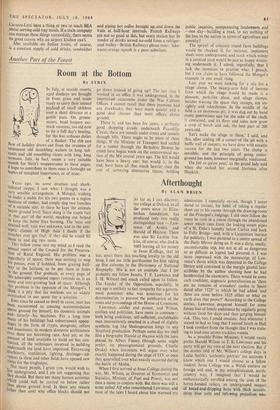Another Part of the Forest
Room at the Bottom
By STRIX hope to contribute to them once a fortnight on topics of marginal importance, or of none.
'Years ago, on some desolate and shark- 'infested steppe', I saw what I thought was a very sensible arrangement. A Mongol, wishing to make a stable for his two ponies in a region 'destitute of timber, had simply dug two trenches eti a suitable size; in these he kept the animals 'below ground level: Since dung is the staple fuel in that parrof the world, mucking out helped to keep the home' fires burning. The loess soil drained' 'well, rain was unknown, and in the anti- septic climate of High Asia I doubt if the trenches ever got foul; if they did he could fill them in and dig two more.
This fellow came into My mind as I read the .annual report of the Council for the Preserva- tion of Rural England. His problem was a superfluity of space; there was nothing to stop his ponies, even if hobbled, from grazing half- .!'vay to the horizon, so he put them in holes In the ground. Our problem, as every page of this admirably compiled report reminds us, is an acute and ever-growing lack of space. Although this problem is the opposite of the Mongol's, think it a pity that his methods are so widely overlooked in our quest for a solution.
Ever since he ceased to dwell in caves, man has been accustomed to creating accommodation above ground for himself, his domestic animals and—latterly—his machines. For a long time many of his buildings had subterranean appen- dages in the form of crypts, dungeons, cellars and basements; in modern domestic architecture even these are becoming rare. And yet, as the amount of land available to build on has con- tracted, all the techniques involved in building
underneath the land have improved. Excavating 4)achinery, ventilation, lighting, drainage—ad- vances in these and other fields have opened new vistas for the troglodyte. Not many people, I grant you, would wish to Jfve underground, and I am not suggesting that they should. But there are many human activities w.,hich could well be carried on below rather 4Iah above ground level. Is there any reason chther than cost) why office blocks should not go down instead of going up? The last time I worked in an office it was underground, in the improvised catacombs [Hider the War Cabinet Offices. I cannot recall that these premises had any drawbacks; they were much quieter and a good deal cleaner than most offices above ground.
There is, and has been for years, a perfectly good shopping arcade underneath Piccadilly Circus; there are tunnels under rivers and tunnels through hills. There ought to be more of these things. If the Minister of Transport had settled for a tunnel through the Berkshire Downs he could have begun work on the controversial sec- tion of the M4 several years ago. The bill would have been a heavy one; but would it, in the end, have been all that much heavier than the cost of surveying alternative routes, holding public inquiries, compensating landowners and —one day—building a road, to say nothing of the loss to the nation in terms of agriculture and amenity?
The sprawl of concrete round farm buildings would be checked if, for instance, implement sheds went underground, and stock which winter in a covered yard would be just as happy winter- ing underneath it. I admit, regretfully, that I lack the resources to practise what I preach, but I can claim to have followed the Mongol's example in one small thing.
Last year we were looking for a site for a silage clamp. The twenty-acre field of lucerne from whidh the silage would be made is a pleasant, park-like place, and silage clamps, besides wasting the space they occupy, are un- sightly and odoriferous. In the middle of the field is an enormous pit; it was dug out by hand many generations ago for the sake of the chalk it contained, and its floor and sides now grow a crop of beech and oak, the best part of 200 years old.
'Let's make the silage in there,' I said, and this, after sealing off a corner of the pit with a baffle wall of sleepers, we have done with notable success for the last two years. The clamp is invisible, and the principle of going under- ground has been, however marginally, vindicated.
'On fait ce qu'on peut; as the grand lady said when she sacked her second footman after Dunkirk.










































 Previous page
Previous page